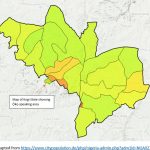Òkó Speaking Communities
Ogori-Magongo people are said to have descended from an adventurous prince of Ile Ife, one of the earliest settlements of the Yoruba ethnic nation. However the language of the community is said to have developed from an admixture of various languages usually referred to as ena (new language – Osheidu, 1990:15). Ò̩kọ, as the language was later called has developed from contact with different linguistic groups in the process of the long migration (both in space and time) from Ife .
The first official census in 1963 puts the population of speakers at ten of thousands. A census in 2006 put the number at about forty thousand (49,807) while the 2016 census states it as 53,700 people. With demographic factors it is speculated that the population of Ogori people worldwide may be between 60 – 70 thousand at present, although a good number have variable proficiency level (from zero – high percentage) in Ò̩kọ language speaking.
Ogori Magongo Local Government Area (LGA) shares boundary with Ososo, Ojah, Makeke, Ekpedo and Olokoto in the south, while Bekuma, Lampese, Ibillo, Imoga are in the south-west — all in Edo State of Nigeria. The Ebiras (of Kogi State) cover the north of Ò̩kọ speaking areas.
Although the people, from Historical accounts (see Akrejola, 1970; Osheidu, 199o and Eika, 2003), went through a rough period in the past, they are settled as a peace loving people.
Ogori and Magongo people are located in the valleys of a range of hills. The people are culturally rich. One festival that has continued to draw national and international crowd is the Ovia-Osese festival, during which teenage girls are formally initiated into womanhood. It is a ceremony in which the community engages in a series of cultural displays and dances, the climax, of which is the “Oke” dance (see “Okitoroko” https://vimeo.com/249759275).
Most cultural activities have faded into oblivion, “Ekon-Orire” which was the male version of Ovia-Osese is still celebrated till now by the Magongo people. For a detailed history and cultural information about the speakers of Ò̩kọ, see the references above.
Ogori-Magongo is the home of Ò̩kọ language. The Local Government Area was created on the 5th December 1996 out of the then Okene Local Government Area, by the administration of late General Sani Abacha. Occupying an area of 73. square meters, it is the second smallest Local Government Area of Kogi State of Nigeria.
Map of Kogi State showing Ogori-Magongo LGA
Adapted from https://www.citypopulation.de/php/nigeria-admin.php?adm1id=NGA023
Map of Ogori-Magongo Local Government Area

it would be wonderful if the oko language is in print.